Text
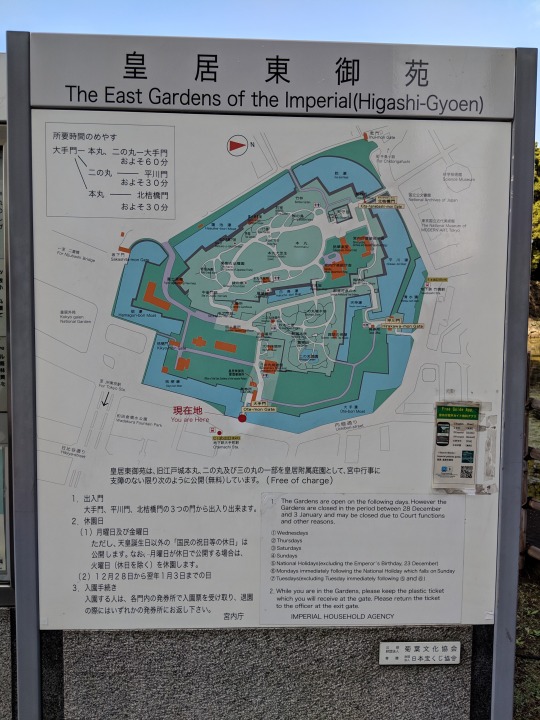
皇居東御苑
The East Gardens of the Imperial (HIgashi-Gyoen)
所要時間
大手本 → 本丸、二の丸ーー大手門
およそ60分
→二の丸、ーーー平川門
およそ30分
→本丸ーーーー北桔橋門
およそ30分
乾門 Inui-mon Gate
至千鳥ヶ淵 For Chidorigafuchi
科学技術館 Science Museum
国立公文書館 National Archives of Japan
東京国立近代武術間 The National Museum of MODERN ART, Tokyo
乾濠 Inui-bori Moat
発券所 Ticket office
北桔橋門 Kita-hanebashi-mon Gate
平川濠 Hirakawa-bori Moat
1a出口 (Exit)
地下鉄 竹橋駅 Takebashi Sta.
清水濠 Shimizu-bori Moat
平川門 Hirakawa-mon Gate
天守台 Tenshudai (Tenshukaku Dunjon Base)
宮内庁書陵部庁舎 Shoryobu (Archives and Mausolea Department Bldg.)
桃華楽堂 Gakubu (Music Department Bldg.)
梅林坂 Bairin-zaka Slope
都道府県の木 Symbolic Prefectural Tree Emblems
天神濠 Tenjin-bori Moat
発券所 Ticket office
大手濠 Ote-bori Moat
内堀通り Uchibori-street
諏訪の茶屋 Suwano-chaya Tea House
竹林 Bamboo Garden
石室 Ishimuro (Stone Cellar)
桜の島 Sakura Blossom Island
富士見多門 Fujimi-tamon Defence-house
バラ園 Rose Garden
茶畑 Tea Garden
ユーロッパアカマツ Scots Pine
本丸 Honmaru
本丸大芝生 Honmaru Oshibafu (Lawn)
本丸休憩所 Honmaru Rest House
汐見坂 Shiomizaka Slope
白鳥濠 Hakucho-bori Moat
展望台 Observatory
二の丸休憩所 Ninomaru Rest House
二の丸雑木林 Ninomaru Grove
秋の七草 The Seven Flowers of Autumn
新雑木林 Renewed Grove
菖蒲田 Iris Garden
二の丸庭園 Ninomaru Garden
蓮池濠 Hausike-bori Moat
松の大廊下跡 Site of Matsuno-o-roka Corridor
果樹古品種園 Orchard (Old Species of Japanese Fruits)
野草の島 Wild Grass Island
緑の泉 Green Fountain
中雀門跡 Site of Chujaku-mon Gate
大番所 O-bansho Guardhouse
中之門跡 Site of Nakano-mon Gate
百人番所 Hyakunin-bansho Guardhouse
同心番所 Doshin-bansho Guardhouse
大手休憩所 Ote Rest House
三の丸尚蔵館 Sannomaru Shozokan The museum of the Imperial Collections
皇居東御苑管理事務所 Office of the East Gardens of the Imperial Palace
発券所 Ticket Office
大手門 Ote-mon Gate
現在地 You are Here
C13b出口 (Exit) Otemachi Sta.
坂下門 Sakashita-mon Gate
富士見櫓 Fujimi-yagura (Mt. Fuji View Keep
蛤濠 Hamaguri-bori Moat
桔梗門 Kikyo-mon Gate
桔梗濠 Kikyo-bori Moat
←至 二重橋 For Nijubashi Bridge
皇居外苑 Kokyi gaien National garden
至 JR東京駅 For Tokyo Sta.
和田倉噴水公園 Wadakura Fountain Park
日比谷通り Hibiya-street
皇居東御苑は、旧江戸城本丸、二の丸及び三の丸の一部を皇居付属庭園として、宮中行事に支障のない限り次のように公開(無量)しています。(Free of charge)
1.出入門
大手門、平川門、北桔橋門の3つの門から出入り出来ます。
2.休園日
(1)月曜日及び金曜日
ただし、天皇誕生日以外の「国民の祝日等の休日」は公開します。なお、月曜日が休日で公開する場合は、火曜日(休日を除く)を休園します。
(2)12月28日から翌年1月3日までの日
3.入園手続き
入園するは、各門内の発券所で入園票を受け取り、退園の際にはいずれかの発券所にお返し下さい。
宮内庁
1.The Gardens are open on the following days. However the Gardens are closed in the period between 28 December and 3 January and may be closed due to Court functions and other reasons.
① Wednesdays
② Thursdays
③ Saturdays
④ Sundays
⑤ National Holidays (excluding the Emperor’s Birthday, 23 December)
⑥ Mondays immediately following the National Holiday which falls on Sunday
⑦ Tuesdays (excluding Tuesday immediately following ⑤ and ⑥)
2.While you are in the Gardens, please keep the plastic ticket which you will receive at the gate. Please return the ticket to the officer at the exit gate.
IMPERIAL HOUSEHOLD AGENCY
公益財団法人菊葉文化協会
寄贈 財団法人日本宝くじ協会
Vocab
皇居(こうきょ)imperial
御苑(ぎょえん)imperial garden
所要時間(しょようじかん)time required, time taken
至(し)to
科学時術(かがくじじゅつ)science and technology
近代美術館(きんだいびじゅつかん)museum of modern art
濠(ほり)moat, canal
発券(はっけん)issuing (a ticket, etc.)
宮内庁(くないちょう)Imperial Household Agency
書陵部(しょりょうぶ)agency that takes care of records and the tombs
庁舎(ちょうしゃ)government office building
梅林(ばいりん)plum grove
都道府県(とどうふけん)prefectures of Japan
竹林(ちくりん)bamboo grove
茶畑(ちゃばたけ)tea field
ユーロッパアカマツ Scots/Scotch pine, Pinus slyvestris
芝生(しばふ)lawn, grass
休憩所(きゅうけいしょ)rest area, rest stop
展望台(てんぼうだい)observation deck
雑木林(ぞうきばやし)thicket; grove of miscellaneous trees
秋の七草(あきのななくさ)seven flowers of autumn: bush clover, Chinese silvergrass, kudzu, fringed pink, golden lace, thoroughwort, and balloon flower
菖蒲(しょうぶ)Japanese iris (Iris ensata var. ensata) [coll.]
果樹(かじゅ)fruit tree
品種(ひんしゅ)breed variety, cultivar
野草(のぐさ)wild grasses
泉(いずみ)fountain
番所(ばんしょ)guardhouse
桔梗(ききょう)Chinese bellflower (Platycodon grandiflorus)
外苑(がいえん)outer garden
噴水(ふんすい)water fountain
付属(ふぞく)being attached (to), belonging (to)
宮中(きゅうちゅう)imperial court
行事(ぎょうじ)event, function
支障(ししょう)obstacle, hindrance
休園日(きゅうえんび)day on which a park (or kindergarten or zoo) is closed
祝日(しゅくじつ)national holiday
なお furthermore
除く(のぞく)to exclude, except
手続き(てつづき)procedure, process
票(ひょう)ticket, stub (suffix)
公益財団法人(こうえきざいだんほうじん)public interest incorporated foundation
文化協会(ぶんかきょうかい)cultural association
公益財団法人菊葉文化協会(こうえきざいだんほうじんきくようぶんかきょうかい)a cultural association that focuses its research on making artifacts of the imperial household available to the public.
寄贈(きぞう)donation, gift
宝くじ(たからくじ)lottery ticket
#日本語#日本#japanese language#japanese langblr#japanese vocabulary#japan#東京#Tokyo#Tokyo imperial gardens#皇居東御苑
12 notes
·
View notes
Text

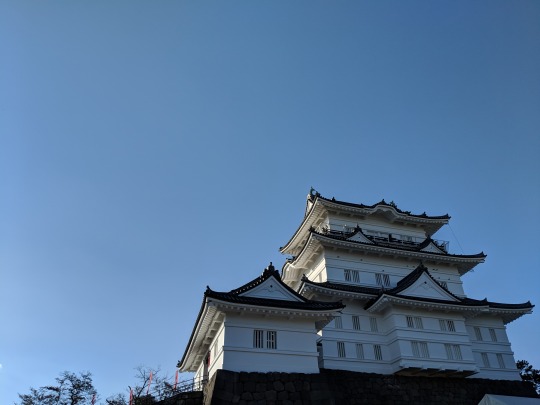
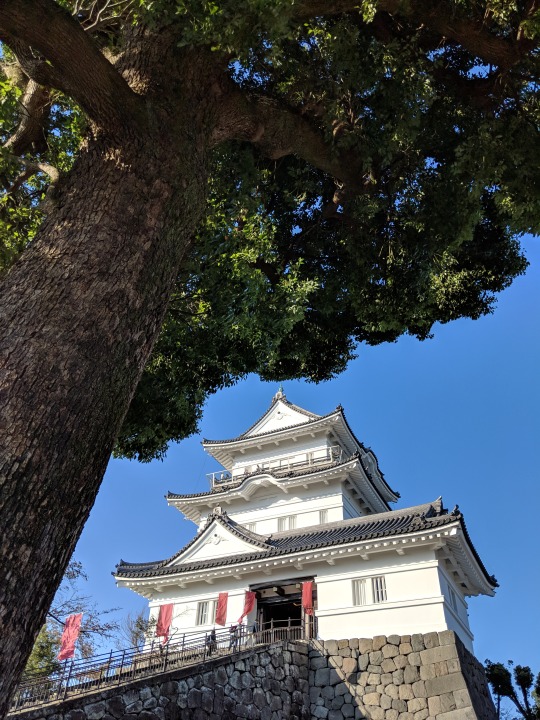
天守閣
小田原城天守閣
「天守」とはお城の象徴ともいえる建物で、お城の内外を見張るための物見櫓や蔵などとして用いられました。江戸時代までは「殿主」「殿守」などとも記され、「天守閣」と呼ばれるのは明治時代になってからのことです。江戸時代の小田原城は江戸の西を守る要の城とされ、徳川将軍家の宿所としても用いられました。寛永11年(1634)には、京都へと向かう途中の三代将軍徳川家光が天守に登り、武具を見たり展望を楽しんだりしたという記録が残っています。
元禄16年(1703)の大地震で、天守を含めた小田原城のほとんどの建物が倒壊・焼失しますが、天守は宝永2年(1705)に外観三層内部四階の「天守櫓」、入り口の「付櫓」、両者を結ぶ「続櫓」の三棟からなる櫓群として再建され、明治3年(1870)の廃城・解体までその姿を保ちました。
現在の天守閣は、昭和35年(1960)に市制20周年の記念事業として鉄筋コンクリート造で復興されたものです。復興に際しては、江戸時代の天守引図(設計図)や模型を参考に外観が復興され、最上階には周囲の景色を楽しめるように高欄が設けられました。
そして、平成28年(2016)には耐震改修工事と展示の全面的なリニューアルが行われました。天守閣内部では古文書や甲冑・刀剣、発掘調査による出土品などを展示し、小田原城の歴史を紹介しています。
標高約60メートルの位置にある最上階からは相模湾が一望でき、晴れた日には三浦半島や伊豆大島、遠く利島、房総半島までを望むことができます。
“Tenshukaku” means “Castle tower”, the symbolic structure of a Japanese castle.
This castle tower served as storehouse, watch tower, or others in Edo period. Having a role to protect the west of Edo, the capital of Japan, the Odawara Castle was a special castle that even the Tokugawa shogunate family stayed at. Although having been demolished during the Meiji period, it was restored in 1960.
Since a large-scale renewal completed in 2015, various historical materials such as armors, swords, etc. have been exhibited inside the structure.
From the topmost floor of the Castle tower, the superb view of the entire Sagami-wan Bay can be enjoyed.
[Chinese]
文久図(小田原城天守閣蔵)
文久年間(1861~1864)に作られたとされる絵図で、幕末期の天守の姿が描かれています。
天守閣入場料 Admission fee
個人 - person | 団体 - Group (more than 30 people)
大人 - (over 15 years old)
500円 (500 en) | 400円 (400 en)
小中学生 - Elementary/Junior high school student
200円 (200 en) | 160円 (160 en)
開館時間:AM9:00~PM5:00 (入館はPM4:30まで)
9:00A.M. - 5:00P.M. (Last admission 30 minutes before closing time)
Vocab
天守閣(てんしゅかく)castle tower, keep, donjon
天守(てんしゅ)castle tower
象徴(しょうちょう)symbol, emblem, representation
内外(ないがい)interior and exterior
見張る(みはる)to stand watch, guard
物見櫓(ものみやぐら)watch tower
用いる(もちいる)to use, make use of
殿主(でんす)(Buddhist) priest in charge of a temple’s clerical duties
殿守(とのもり)palace guard [same for 主殿(とのも)]
記する(きする)to remember, to note
とされる )…is considered to…
将軍家(しょうぐんけ)family positioned to accede the shogunate
宿所(しゅくしょ)address, lodgings, accomodations
途中(とちゅう)en route
徳川家光(とくがわいえみつ)Tokugawa Iemitsu
武具(ぶぐ)arms, weapons
展望(てんぼう)view, outlook
元禄(げんろく)Genroku era (9.30.1688-3.13.1704)
ほとんど almost all (of)
倒壊(とうかい)destruction, collapse
焼失(しょうしつ)destruction by fire, being burnt down
宝永(ほうえい)Hoei era (3.13.1704-4.25.1711)
外観(がいかん)outward appearance
付櫓(つけやぐら)attached turret/watchtower
両者(りょうしゃ)pair, two people, two things
続櫓(ぞくやぐら)a row house watchtower that continues from the gate watchtower)(櫓門)
棟(とう)counter for buildings
群(ぐん))group
廃城(はいじょう)abandoned castle
解体(かいたい)demolition, taking down
保つ(たもつ)to keep, preserve
市制(しせい)municipality
鉄筋コンクリート(てっきんコンクリート)reinforced concrete
復興(ふっこう)reconstruction, restoration
に際して(にさいして)at the time of, during
設計図(せっけいず)plan, blueprint
模型(もけい)model
最上階(さいじょうかい)top floor
高欄(こうらん)railing
設ける(もうける)to prepare, provide
耐震(たいしん)resistant to earthquakes
改修工事(かいしゅうこうじ)repair work
展示(てんじ)exhibition, display
全面的(ぜんめんてき)total, complete, extensive
古文書(こぶんしょ)historical document, archives
甲冑(かっちゅう)armor and helmet
刀剣(とうけん)sword
発掘(はっくつ)excavation
出土品(しゅつどひん)artefact, archaeological find
標高(ひょうこう)elevation
相模湾(さがみわん)Sagami Bay
一望(いちぼう)sweeping/unbroken view
三浦半島(みうらはんとう)Miura Peninsula
伊豆大島(いずおおしま)Izu Oshima
利島(としま)Toshima Island
房総半島(ぼうそうはんとう)Boso Peninsula
望む(のぞむ)to expect, hope for, look forward to
入場料(にゅうじょうりょう)admission fee
入館(にゅうかん)entrance (into a library, museum, etc.)
#日本語#japanese language#japanese langblr#japanese vocabulary#日本#japan#japanese history#日本歴史#odawara#小田原城#Odawara castle#小田原市#and with that I'm through with Odawara :D Pics from Tokyo will be next
17 notes
·
View notes
Text

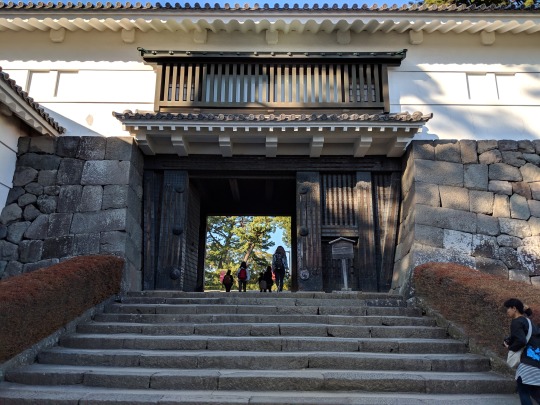
小田原城 常盤木門
本丸の正面に一位し、小田原城の城門の中でも、最も大きく堅固に造られていた。古絵図などの記録から、江戸時代初期から設けれられていたことが分かる。
元禄16年(1703)の大地震で崩壊した後、宝永3年(1706)に、大門櫓と渡り櫓から構成される桝形門形式で再建されたものが、明治3年(1870)の小田原城廃城まで姿をとどめていたといわれている。
現在の常盤木門は、市制30周年事業として、明治時代初期に撮影された写真などを参考に再建したもので、昭和46年(1971)3月に完成した。
常盤木門とは常緑樹の意で、門の傍らには往時から松が植えられており、また、松の木が常に緑色をたたえて何十年も生長することになぞらえ[た?]小田原城が永久不変に繁栄することを願って、常盤木門と名付けられたといわれている
Odawara Jo Tokiwagi Mon
Odawara Castle Tokiwagi Gate
During the Edo Period (1603-1867), various types of castle gates stood on the castle grounds. The gate which is located in the east corner of the central bailey was the main entrance and the most strategic place for the defense of the castle. This gate was named Tokiwagi (“Evergreen”), because there were old pine trees nearby. The feudal lord believed that the pine trees would stand forever, and wished the same for the castle.
At the beginning of the Meiji Period (1870), most of structures on the castle grounds, including the original gate and the donjon, were []ted. The present gate was rebuilt in 1971 and the donjon was []n 1960.
江戸時代初期の城絵図(小田原市国立図書館蔵)
Vocab
常盤木門(ときわぎもん)Tokiwagi Gate
城門(じょうもん)castle gate
堅固(けんご)solid, strong, firm
設ける(もうける)to set up, establish
元禄(げんろく)Genroku era (9.30.1688-3.13.1704)
大地震(おおじしん)major earthquake
崩壊(ほうかい)collapse, crumbling
宝永(ほうえい)Hoei era (3.13.1704-4.25.1711)
櫓(やぐら)turret, watchtower
門櫓(もんやぐら)turrets built on top of gates (since the Kamakura period)
渡り櫓(わたりやぐら)a row house built on top of a castle wall
構成(こうせい)construction, organization
桝形(ますがた)rectangular space between the inner and outer gates of a castle (where troops can gather)
廃城(はいじょう)abandoned castle
とどめる) to keep (in position, in place)
市制(しせい)municipal organzation, municipality
周年(しゅうねん)nth year anniversary
撮影(さつえい)photography
参考(さんこう)reference
常緑樹(じょうりょくじゅ)evergreen tree
意(い)meaning
傍らに(かたわらに)beside, nearby
往時(おうじ)ancient times
常に(つねに)always, constantly
たたえる )to fill, be filled with
生長(せいちょう)growth (of a plant)
なぞらえる) to liken to, compare to
永久不変(えいきゅうふへん)permanence, forever unchanging
繁栄(はんえい)prosperity, flourishing
名付ける(なづける)to name, call
#日本語#japanese language#japanese langblr#japanese vocabulary#日本#japan#japanese history#日本歴史#odawara#小田原城
8 notes
·
View notes
Text
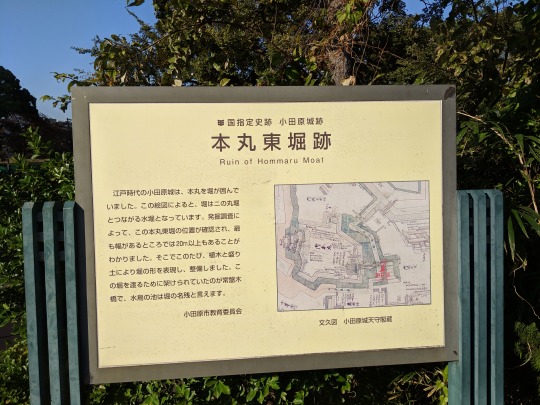
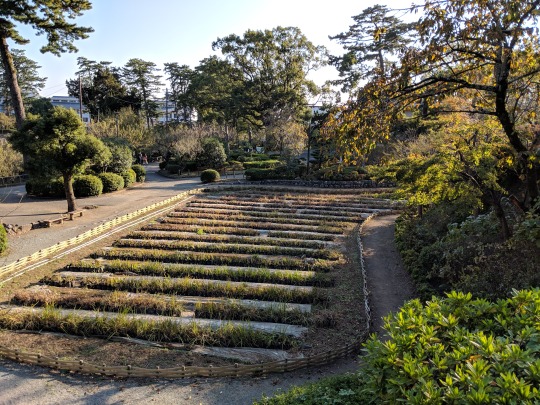
国指定史跡 小田原城跡
本丸東堀跡
Ruin of Honmaru Moat
江戸時代の小田原城は、本丸を堀が囲んでいました。この絵図によると、堀は二の丸堀とつながる水堀となっています。発掘調査によって、この本丸東堀の一位が確認され、最も幅があるところでは20m以上もあることがわかりました。そこでこのたび、植木と盛り土により堀の形を表現し、整備しました。この堀を渡るために架けられていたのが常盤木橋で、水鳥の池は堀の名残と言えます。
小田原市教育委員会
文久図 小田原城天守閣蔵
Vocab
史跡(しせき)historic site, historic landmark
絵図(えず)illustration, drawing
水堀(みずほり)moat
発掘調査(はっくつちょうさ)excavation, dig
幅(はば)width, breadth
植木(うえき)garden shrubs, trees, potted plant
盛り土(もりど)embankment (for road, railway)
表現(ひょうげん)expression, representation, description
整備(せいび)development, preparation, equipment
架ける(かける)to build (a bridge, etc.)
常盤木(ときわぎ)Tokiwagi
木橋(もっきょう)wooden bridge
水鳥(みずとり)waterfowl
名残(なごり)remains, traces, vestiges, relics
文久(ぶんきゅう)Bunkyu era (2.19.1861-2.20.1864)
天守閣(てんしゅかく)castle, keep, donjon
蔵(ぞう)possession (suffix)
#日本語#japanese language#japanese langblr#japanese vocabulary#日本#japan#japanese history#日本歴史#odawara#小田原城
25 notes
·
View notes
Text
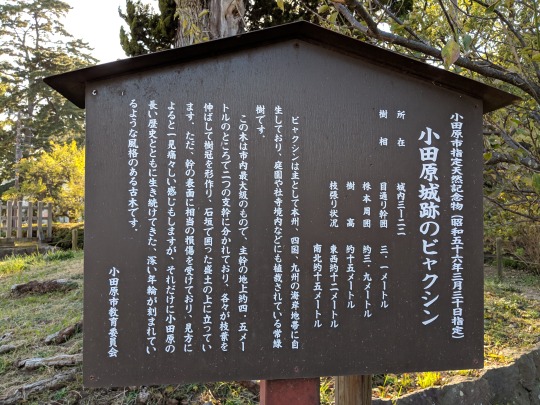

小田原市指定天然記念物 (昭和五十六年三月三十日指定)
小田原城跡のビャクシン
所在 城内三ー二二
目通り幹囲 三・一メートル
株本周囲 約三・九メートル
樹高 約十五メートル
枝張り状况 東西約十二メートル
南北約十五メートル
ビャクシンは主として本州、四国、九州の海岸地帯に自生しており、庭園や社寺境内などにも植栽されている常緑樹。
この木は市内最大級のもので、主幹の地上約四・五メートルのところで二つの支幹に分かれており、各々が枝葉を伸ばして樹冠を形作り、石垣で囲った盛土の上に立っています。ただ、幹の表面に相当の損傷を受けており、見方によると一見痛々しい感じもしますが、それだけに小田原の長い歴史とともに生き続けてきた、深い年輪が刻まれているような風格のある古木です。
小田原市教育委員会
Vocab
指定(してい)designation, assignment
天然(てんねん)nature
記念物(きねんぐつ)memorial
ビャクシン Chinese juniper (Juniperus chinemsis)
所在(しょざい)location, whereabouts
目通り(めどおり)diameter of a tree trunk at eye level
幹囲(かんい)trunk circumference
樹高(じゅこう)tree height
主として(しゅとして)mainly, chiefly
四国(しこく)Shikoku
海岸(かいかん)coast
地帝(ちたい)zone, area, region
自生(じせい)wild/natural growth
社寺(しゃじ)shrines and temples
境内(けんだい)(grounds (esp. Of temples and shrines)
植栽(しょくざい)raising trees and plants
常緑樹(じょうりょくじゅ)evergreen tree
最大級(さいだいきゅう)largest class, top category
主幹(しゅかん)main trunk
支幹(しかん)a second trunk that splits from the main trunk
分かれる(わかれる)to branch, fork, diverge
各々(おのおの)each
枝葉(えだば)branches and leaves, foliage
樹冠(じゅかん)tree canopy, tree crown
形作り(かたちづくり)to form, shape, build
石垣(いしがき)stone wall
囲う(かんこう)to enclose, surround
盛土(もりど)embankment (for road, railway), raising the ground level
表面(ひょうめん)surface, exterior
相当(そうとう)considerable, substantial
損傷(そんしょう)damage, energy
見方(みかた)viewpoint
一見(いっけん)at first glance
痛々しい(いたいたしい)pitiful, pathetic, paintful to look at
それだけに which is precisely why, it's precisely for that reason that
年輪(ねんりん)annual tree ring
刻む(きざむ)to tick away (time), to record the passing moment
風格(ふうかく)personality, style, appearance
古木(こぼく)old tree
12 notes
·
View notes
Text


さくら名所100選の地
小田原城址公園・城山公園
平成2年3月3日
財団法人 日本さくらの会
Vocab
名所(めいしょ)famous place; place of (scenic or historical) interest
小田原城址公園(おだわらじょうしこうえん)Odawara Castle Park
城山公園(しろやまこうえん)Shiroyama Park
財団法人(ざいだんほうじん)foundation (non-profit)
8 notes
·
View notes
Text

二の丸隅櫓
江戸時代、小田原城には5棟の二重櫓と1棟の平櫓がありました。この櫓は、関東大震災(大正12年:1923)後に再建された櫓で、二の丸隅櫓とも呼ばれています。延宝元年(1673)もしくはその翌年に2間 x 6間(約3.6m x 11m)土蔵としてはじめて建設されました。しかし、元禄16年(1703)の地震により倒壊し、奥行2間、折廻し7間(約13m)の鍵の手状の平櫓として再建されました。
小田原藩主居館がある二の丸の南東の隅に位置し、三の丸の大手門を入ると正面にこの平櫓が立ちはだかることになります。また、二の丸への入り口である馬出門を見下ろす位置でもあります。当時の櫓内部では武具等が保管され、小田原城防御の要とも言える櫓でした。
この平櫓だけが小田原城内唯一の建物として残されましたが、関東大震災により失われてしまいました。
現在の櫓は、江戸時代のものとは異なり、大きさは一回り小さいものとなっています。
During the Edo period, the Odawara Castle had five Niju Yagura (two-story turrets) and one Hira Yagura (single turret). This one is a single turret also known as a Sumi Yagura (Corner turret) of Ninomaru.
Storing arms and weapons inside, the turret, keeping an eye on both Ote-mon as well as Umadashi-mon Gates, had the most important role in a defense of the Odawara Castle.
In Meiji period, after many structures within the complex of Odawara Castle were demolished, only this Hira-yagura turret remained.
However, it was destroyed by the Great Kanto Earthquake of 1923, and the present one was reconstructed later. Unlike the one in the Edo period, the present turret here is a size smaller.
[Chinese]
Top picture:
The Imperial Villa, Odawara 邸用御趾城原田小
明治42年(1909)〜大正12年(1923) 頃の姿
Bottom picture:
Goyote Odawara, Sagami 邸用御原田小州相
明治42年(1909)〜大正12年(1923) 頃の姿
*Note, the Japanese on the first lines of these pictures appear to be backwards on the original.
Vocab
櫓 (やぐら)turret, watchtower
延宝(えんぽう)Enpō era (9.21.1673-9.29.1681)
元年 (がんねん)first year (of an imperial era)
もしくは or, otherwise
間(けん)ken (6 shaku, approx. 1.818 m)
土蔵(どぞう)storehouse with thick (earthen) walls
元禄(げんろく)(Genroku era (9.30.1688-3.13.1704)
倒壊(とうかい)destruction, collapse
奥行(おくゆき)length
折廻(おりまわり)to provide the bend for the kagi no te
鍵の手(かぎのて)section of road that is curved on purpose as a defensive measure (see here)
藩主(はんしゅ)feudal lord, daimyo
居館(きょかん)residence, estate
大手門(おおてもん)front castle gate
立ちはだかる(たちはだかる)to stand in the way, block the way
馬出(うまだし)Umadashi
見下ろす(みおろす)to overlook, command a view of
武具(ぶぐ)weapons, armor
保管(ほかん)custody, storage
防御(ぼうぎょ)defense, safeguard
要(かなめ)cornerstone, vital point
唯一(ゆいいち)only, sole, unique
異なり(けなり)unlike
一回り(ひとまわり)one size (larger or smaller)
城趾(じょうし)castle site
御用邸(ごようてい)imperial villa
#日本語#japanese language#japanese langblr#japanese vocabulary#日本#japan#日本歴史#japanese history#odawara#小田原城
14 notes
·
View notes
Text

大手筋登城順路
Main Route to the Castle通徃城樓主道
銅門 Akaganemon Gate
歴史見聞館 Rekishi-Kenbunkan (Museum)
報徳二宮神社 Hotoku Ninomiya jinja Shrine
Vocab
大手筋(おおてすじ)large-scale operators, big traders
登城(とじょう))attendance at a castle
順路(じゅんろ))(regular) route, suggested route
見聞(けんぶん))information, experience, knowledge
23 notes
·
View notes
Text
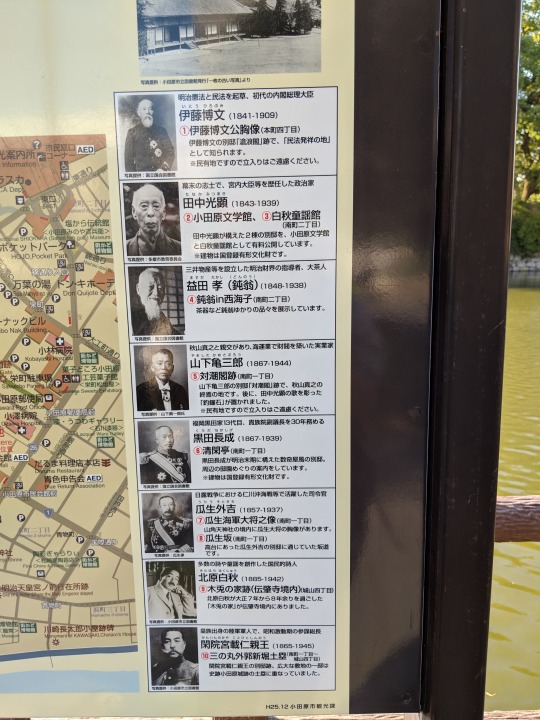
写真提供: 小田原市立図書館発行[一枚の古い写真]より
明治憲法と民法を起草、初代の内閣総理大臣
伊藤博文 (1841-1909)
1] 伊藤博文公胸像 (本町四丁目)
伊藤博文の別邸[滄浪閣]跡で[民法発祥の地]として知られます。
*民有地ですので立入りはご遠慮ください。
写真提供: 国立国会図書館
幕末の志士で、宮内大臣等を歴任した政治家
田中光顕 (1843-1939)
2] 小田原文学館、3] 白秋童謡館 (南町二丁目)
田中光顕が構えた2棟の別邸を、小田原文学館と白秋童謡館として有料公開しています。
*建物は国登録有形文化財
写真提供:多摩市教育委員会
三井物産等を設立した明治財界の指導者、大茶人
益田孝 (鈍翁) (1848-1938)
鈍翁in西海子(南町二丁目)
茶器など鈍翁ゆかりの品々を展示しています。
写真提供: 国立国会図書館
秋山真之と親父があり、海運業で財閥を築いた実業家
山下亀三郎 (1867-1944)
5] 対潮閣跡 (南町一丁目)
山下亀三郎の別邸[対潮閣]跡で、秋山真之の終焉の地です。後に、田中光顕の歌を彫った[釣鐘石]が置かれました。
*民有地ですので立入りはご遠慮ください。
写真提供:山下真一郎氏
福岡黒田家13代目、貴族院副議長を30年務める
黒田長成 (1867-1939)
[6]清閑亭 (南町一丁目)
黒田長成が明治末期に構えた数奇屋風の別邸。周辺の庭園めぐりの案内をしています。
*建物は国登録有形文化財
写真提供: 国立国会図書館
日露戦争における仁川沖海戦等で活躍した司令官瓜生外吉 (1857-1937)
7] 瓜生海軍大将之像 (南町一丁目)
山角天神社の境内に瓜生大将の胸像があります。
8] 瓜生坂 (南町一丁目)
高台にあった瓜生外吉の別邸に通じていた坂道です。
写真提供:瓜生家
多数の詩や童謡を創作した国民的詩人
北原白秋 (1885-1942)
9] 木兎の家跡(伝肇寺境内)(城山四丁目)
北原白秋が大正7年から8年余りを過ごした[木兎の家]が伝肇寺境内にありました。
写真提供: 小田原市立図書館
皇族出身の陸軍軍人で、昭和激動期の参謀総長
閑院宮載仁親王 (1865-1945)
10] 三の丸外郭新掘土塁(南町一丁目〜城山四丁目)
閑院宮載仁親王の別邸跡。広大な敷地の一部は史跡小田原城跡の土塁に重ねっていました。
写真提供: 小田原市立図書館
H25.12 小田原市観光課
Vocab
提供 (ていきょう) providing, donating
発行(はっこう)publication
憲法(けんぽう) constitution
民法(みんぽう) civil code, civil law
起草(きそう) (drafting (a bill, etc.), drawing up
内閣総理大臣 (ないかくそうりだいじん)prime minister (of a cabinet government)
伊藤博文 (いとう・ひろぶみ)Itou Hirobumi
公 (おおやけ)official, governmental, formal
胸像 (きょうぞう)half-length portrait
別邸 (べってい)secondary residence, vacation home
滄浪閣 (そうろうかく)Sorokaku
発祥の地(はっしょうのち) origin, birthplace
民有地 (みんゆうち)private land
ご遠慮ください(ごえんりょください)please refrain (from)
国立国会図書館(こくりつこっかいとしょかん)National Diet Library
幕末(ばくまつ)Bakumatsu period
志士 (しし)imperial loyalist samurai of the Bakumatsu-era
宮内大臣(くないだいじん)Minister of the Imperial Household
歴任 (れきにん)successive/consecutive jobs
政治家(せいじかん)politician, statesman
田中光顕(たんか・むつあき)Tanaka Mitsuaki
文学館(ぶんがくかん)literary museum
白秋(はくしゅう)Hakushu (see below)
童謡(どうよう)nursery rhyme
構える(かまえる)to build, set up
棟(とう)counter for buildings
有料(ゆうりょう)fee-charging
公開(こうかい)open to the public
有形文化財(ゆうけいぶんかざい)tangible cultural properties
多摩市(たまし)Tama City
三井物産(みついぶっさん)Mitsuri & Co.
設立(せつりん)establishment, foundation
財界(ざいかい)financial world, business circles
茶人(ちゃじん)master of the tea ceremony
益田孝(ますだ・たかし)Masuda Takashi
鈍翁(どんのう)Donnou, an alias he took on as a tea master
西海子(さいかいし)Saikaishi
茶器(ちゃき)tea utensils
ゆかりconnection (to a person, place, or thing)
品々(しなじな)various articles
展示(てんじ)exhibition, display
秋山真之(あきやま・さねゆき)Akiyama Saneyuki
海運業(かいうんぎょう)shipping industry, marine transport
財閥(ざいばつ)zaibatsu, financial conglomerate
築く(きずぐ)to build up, establish
実業家(じつぎょうか)business, entrepreneur
山下亀三郎(やました・かめさぶろう)Yamashita Kamesaburo
対潮閣(たいちょうかく)Taichokaku
終焉(しゅうえん)end (of life), death; (peacefully) spending one’s final years
彫る (ほる)to carve, engrave
釣鐘石 (つりがねいし)Tsurigane-ishi (Hanging Bell-shaped Rock)
代目(だいめ)nth generation
貴族院(きぞくいん)House of Peers (Meiji constitution)
副議長(ふくぎちょう)vice-chairman
黒田長成(くろだ・ながしげ)Kuroda Nagashige
数奇屋(すきや)tea-ceremony arbor
めぐり tour
教育委員会(きょういくいいんかい)board of education
日露戦争(にちろせんそう)Russo-Japanese War
における in, at, on, regarding
仁川沖海戦(じんせんおきかいせん)Battle of Chemulpo Bay (Feb. 9, 1904)
仁川(インチョン)Incheon
活躍(かつやく)activity, great efforts, active participation
司令官(しれいかん)commanding officer, general
瓜生外吉(うりう・そときち)Uryu Sotokichi
海軍大将(かいぐんたいしょう)admiral
之(の)of
山角天神社(やむかくてんじんじゃ)Yamakakuten Shrine
境内(けいだい)grounds (esp. of temples and shrines)
坂(さか)milestone; slope, hill
高台(たかだい)high ground, hill
坂道(さかみち)hill road
創作(そうさく)creative work
国民的(こくみんてき)popular on a national level
北原白秋(きたはら・はくしゅう)Kitahara Hakushuu
木兎(つく)horned owl (rarely used kanji form)
伝肇寺(でんじょうじ)Denjo-ji Temple
皇族(こうぞく)imperial family
陸軍(りくぐん)army
軍人(ぐんじん)soldier
激動(げきどう)turmoil, upheaval
参謀総長(さんぽうそうちょう)chief of general staff
閑院宮載仁親王(かんいんのみやことひとしんのう)Prince Kan’in Kotohito
外郭(がいかく)outer fence, outer enclosure
土塁(どるい)earthen walls
広大(こうだい)immense, huge, grand
敷地(しきち)site, plot, grounds
史跡(しせき)historic site
#日本語#日本#japanese langblr#japanese vocabulary#japan#japanese history#日本歴史#japanese language#Odawara#小田原
12 notes
·
View notes
Text

国指定史跡小田原城跡
二の丸東堀
指定 昭和13年8月8日
小田原城は、江戸幕府の三代将軍家光の乳母、春日局の子稲葉正勝が寛永9年(1632)城主になると、大規模な工事が行われ、石垣を備える近世城郭として整備されました。
二の丸東堀は、本丸・二の丸を守る堀の中でもっとも大きなもので、幅は最大で約40mあり、現在よりもさらに北に約60m先まで続いてしました。また、西は常磐木橋、南は南曲輪の前までつながっていました。
現在の石垣は、大正12年(1923)の関東大震災で崩れたものを昭和初期に復旧したものですが、石の写真のとおり、江戸時代の石垣は今のものよりも高く、二の丸の石垣として威厳のある姿を見せていました。
なお、震災直後、一時この堀を埋め立てる計画がありましたが、小田原保勝会が中心となって保存運動を起こし、その結果二の丸東堀は、今日までその姿を残すことができました。
小田原市教育委員会
文久図 (江戸時代末期)
現在地
明治36年頃の二の丸東堀
(絵葉書[相州名所 小田原城址 御用邸])
馬出門 Umadashimon Gate
銅門 Akaganemon Gate
馬出門
馬出門は、三の丸から二の丸に向かう大手筋(正規登城ルート)に位置する門です。寛文12年(1672)に枡形形式に改修され、江戸時代末期まで存続しました。
石垣と土塀で四角く囲んだ枡形と、本柱と控柱を備えた高麗門形式の馬出門・内冠木門の二つの門から成ります。
銅門
銅門は、大手筋に位置する二の丸主部への表門で、寛永10年(1633)には完成していたものと考えられています。
入母屋造瓦葺の渡櫓門で、銅門は大扉を銅鋲で飾ったことに由来します。[勢溜]と呼ばれる広場の前には、突出部が設けられて住吉橋の橋会が造られ、住吉門が据えられています。
Vocab
史跡 (しせき)historic landmark
小田原 (おだわら)Odawara
城跡 (しろあと)castle site
二の丸(にのまる)outer citadel
堀 (ほり)moat
将軍 (しょうぐん)shogun
家光 (いえみつ)(Tokugawa) Iemitsu
乳母 (うぼ)wet nurse
春日局 (かすがのつぼね)Lady Kasuga
稲葉正勝 (いなば・まさかつ)Inaba Masakatsu
寛永 (かんえい)Kan’ei era
城主 (じょうしゅ)lord of a castle
大規模 (だいきぼ)large scale
工事 (こうじ)construction work
石垣 (いしがき)stone wall
備える (そなえる) to prepare for
近世 (きんせい)early modern period(from the end of Azuchi-Momoyama period to the end of the Edo period)
城郭 (じょうかく)castle, citadel, fortress
整備 (せいび)maintenance
本丸 (ほんまる)inner citadel
幅 (はば)width, breadth
常磐 (ときわ)Tokiwa
木橋 (もっきょう)wooden bridge
曲輪 (くるわ)(refers to things both inside and outside of the castle grounds (incl. the walls, moat, (etc.)
関東大震災 (かんとうだいしんさい)Great Kanto Earthquake of 1923
復旧 (ふっきゅう)restoration
なお furthermore
埋め立てる (うめたてる)to fill up, reclaim
保勝 (ほしょう)preservation of a place of scenic beauty
残す (のこす)to leave undone, not finish
文久 (ぶんきゅう)Bunkyu era (2.19.1861-2.20.1864)
絵葉書 (えはがき)picture postcard
御用邸 (ごようてい)imperial villa
三の丸 (さんまる)outermost region of the castle
大手筋 (おおですじ)large-scale operators
正規 (せいき)regular, normal
登城 (とじょう)attendance at a castle
寛文 (かんぶん)Kanbun era (4.25.1661-9/21/1673)
枡形 (ますがた)rectangular space between the inner and outer gates of a castle (where troops can gather)
改修 (かいしゅう)repair, improvement
存続 (そんぞく)continuance
土塀 (とべい)earthen wall
控柱 (ひかえばしら)secondary pillars
備える (そなえる)to furnish/equip with, install
高麗門 (こうらいもん)Koraimon, a style of gate architecture that consists of a tiled gabled roof with two pillars and two smaller roofs over the 控柱
冠木門 (かぶきもん)Kabukimon, a gate in a wall formed by two square posts and a horizontal beam
から成る (からなる)to consist of, be composed of
主部 (しゅぶ)main/principal part
表門 (おもてもん)front gate
入母屋造 (いりもやづくり)Irimoya, a building with a hipped, gabled roof
瓦葺 (かわらぶき)tile roofing
櫓門 (やぐらもん)Yaguramon, a gate with a tower/turret on top
渡櫓 (わたるやぐら)a turret built on top of a stone wall
銅 (どう)copper
鋲 (びょう)rivet
勢溜 (せいがまり)a place where troops can gather and prepare
突出部 (とっしゅつぶ)extrusion, overhang
設ける (もうける)to prepare, provide
住吉橋 (すみよしばし)Sumiyoshi Bridge
据える (すえる)to place (in position), to lay (foundation)
https://tetsugakunomichi.jp/about.html (defines 保勝 as 景勝地の保全)
#日本語#Japanese langage#Japanese vocabulary#Japanese langblr#日本#Japan#小田原市#Odawara#小田原城#Odawara Castle#Japanese history#日本歴史#tumblr has made it significantly harder to apply my color coding but gdi I'm going to finish this project
16 notes
·
View notes
Text

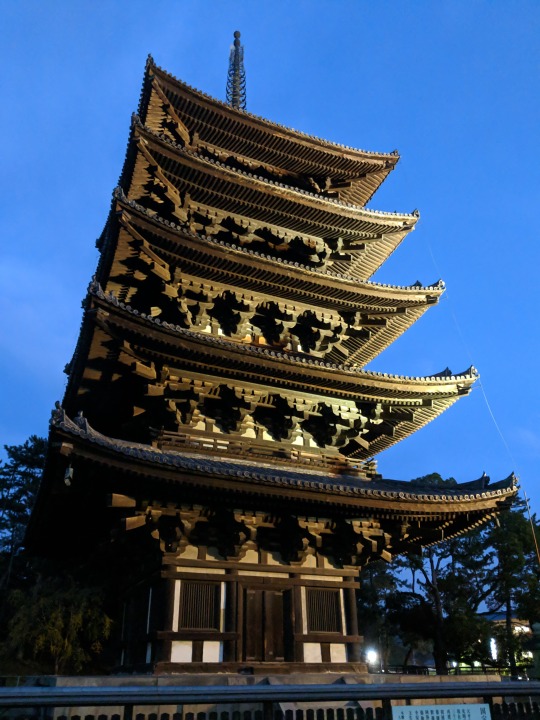
国宝興福寺五重塔
室町時代 高さ五◯、一m
天平二年(七三◯)に光明皇后が創建。現在の塔は応永三十三年(一四二六)に再建。
初層の須弥壇に
薬師三尊像(東)
釈迦三尊像(南)
阿弥陀三尊像(西)
弥勒三尊像(北)
を安置(いずれも室町時代作)。
文化財を大切にしましょう。
木柵の中には入らないでください。
The Five Storied Pagoda (National Treasures)
This pagoda was constructed by the Empress Komyo in 730. The current building is a restoration completed in 1426, and is the second highest pagoda in Japan, rising 50.1 meters. Inside the structure on the first level, enshrined around the central pillar are a Yakushi triad (to the east), a Shaka triad (to the south), an Amida triad (to the west), and a Miroku triad (to the north).
Vocab
室町時代 (むろまちじだい) Muromachi period (1336-1573)
天平 (てんぴょう) Tenpyo era (8.5.729-4.14.749)
光明皇后 (こうみょうこうごう) Empress Komyo
創建 (そうけん) establishment, foundation
応永 (おうえい) Oei era (7.5.1394-4.27-1428)
須弥壇 (しゅみだん) dais for a Buddhist image
薬師 (やくし) Bhaisajagyuru, Yakushi, the Healing Buddha
三尊 (さんぞん) a Buddhist triad; a Buddha attended by two boddhisatvas
尊像 (そんぞう) statue of a noble character
釈迦(しゃか) Shakyamuni, Gautama Buddha
阿弥陀 (あみだ) Amitabha, Amida
弥勒 (みろく) Maitreya (boddhisatva), Miroku
安置 (あんち) enshrinement, installation (of an image)
いずれも all, every
木柵 (もくさく) wooden fence
#日本語#japanese language#japanese vocabulary#japanese langblr#日本#japan#奈良#Nara#仏教#日本歴史#Buddhism#Japanese history
45 notes
·
View notes
Photo

春日東西両塔跡
春日塔跡は春日大社の一の鳥居を入った参道の左側 (現在の奈良国立博物館構内) に、東西に並ぶ2基の塔跡である。神仏習合思想にもとづいて神社にも仏教の塔を建立した代表的遺構であり、両塔のありし日の偉容は多くの春日宮曼荼羅に描かれている。
西塔(現在地より西へ約90m)永久4年(1116)に関白藤原忠実により造営され、東塔(現在地)は鳥羽上皇の本願により保延6年(1140)に建立された。そのため西塔は"殿下の御塔"、東塔は"院の御塔"と称されていた。ところが治承4年(1180)に平重衡の南部焼打にあって焼失し、相次いで再建されたものの、応永18年(1411)の雷火にあって再び焼失した。その後は再建されることなく今日におよんでいる。
両塔は、1965年(昭和40)の発掘調査によって規模や構造が明確になった。その規模は興福寺五重塔とほぼ同じであり、高さ約50m、初層の一辺長約8.6mで、東塔の初層には裳階がつけられていた。また塔の南正面には複廊を築いて数門を設け、東、西、北の三方には一辺約100mの築地をめぐらしていた。
奈良国立博物館
東塔跡 (東より 1965年発掘時)
西塔跡 (西より 1965年発掘時)
現在地
東塔
西塔
春日宮曼荼羅 部分 (奈良市南市町自治会蔵 鎌倉時代 重要文化財)
Vocab
春日 (かすが)Kasuga
東西 (とうざい)east and west
塔跡 (とうあと)ruins of a tower
春日大社 (かすがたいしゃ)Kasuga-taisha
参道 (さんどう)road approaching a shrine
構内 (こうない)premises, grounds
神仏習合 (しんぶつしゅうごう)Shinto-Buddhist syncretism
建立 (こんりゅう)(act of) building (temple, monument, etc.)
遺構 (いこう)(archaeological) remains
ありし日 (ありしひ)the olden days, days of yore
偉容 (いよう)dignified/majestic/imposing appearance
宮曼荼羅 (みやまんだら)shrine mandala
永久 (えいきゅう)Eikyuu era (7.13.1113-4.3.1118)
関白 (かんぱく)chief advisor to the Emperor
藤原忠通 (ふじわらの・ただざね)Fujiwara no Tadazane
造営 (ぞうえい)building (a temple, palace, etc.)
鳥羽天皇 (とば)Emperor Toba
(じょうこう)retired emperor
本願 (ほんがん)Amida Buddha’s original vow/Primal Vow
保延 (ほうえん)Hoen era (4.27.1135-7.10.1141)
殿下の御塔 (てんかのみとう)Tenka no mitou
称す (しょうす)to take the name of
治承 (じしょう)Jisho era (8.4.1177-7.14.1181)
平重衡 (たいらの・しげひら)Taira no Shigehira
南部 (なんぶ)southern part; the south (of a region)
焼打 (やきうち)setting on fire
焼失 (しょうしつ)destruction by fire
相次いで (あいついで)one after the other, successively
ものの although, despite the fact
応永 (おうえい)Oei era (7.5.1394-4.27.1428)
雷火 (らいか)fire caused by lightning
及ぶ (およぶ)to befall, to happen to, to go on (for, until)
発掘調査 (はっくつちょうさ)excavation, dig
規模 (きぼ)scale, scope, plan, structure
興福寺 (こうふくじ)Kofuku-ji
一辺 (いっぺん)side of a geometic shape
裳階 (もこし)pent roof (below the true roof of a pagoda, etc.)
複 (ふく)multiple
廊 (ろう)corridor, passage, hall
築く (きずく)to build, construct
設ける (もうける)to set up, establish
築地 (ついじ)mud wall with a roof
巡らす (めぐらす)to enclose (with), surround (with)
自治会 (じちかい)neighborhood council
蔵 (ぞう)possession, ownership
14 notes
·
View notes
Photo


ムクロジ
樹高 一五、五m
幹周 四、五八m
(地上一、三m)
日本では中部以西の山野に自生は、春日山にも多く生えている。果皮には大量のサポニンが含まれるため、かつて石鹸としても利用されていた。
種子は正月の羽根突きの球や数珠に使われた。
春日大社
Mukuroji (Sapindus mukorossi)
Height 15.5 m Circumference 4.58m
It is found in the mountains west of Central Japan. It is often seen in Mt. Kasaguyama. Since its seedcase has a lot of saponin composition, it used to use as soap. Its seed was used as a ball for battledore and shuttlecock, and Buddhist rosary.
Vocab
ムクロジ soapnut tree
樹高 (じゅこう)tree height
幹 (みき)tree trunk
地上 (ちじょう)above the ground
中部 (ちゅうぶ)Chubu region
以西 (いせい)and westward; west of
山野 (さんや)countryside; hills and fields
自生 (じせい)natural growth, wild growth
春日山 (かすがやま)Kasugayama
生える (はえる)to grow
果皮 (かひ)skin (of a fruit), peel, rind
かつて formerly, before
石鹸 (せっけん)soap
種子 (しゅし)seed, pit
正月 (しょうがつ)new year
羽根突き (はねつき)hanetsuki (Japanese badmitton)
数珠 (じゅず)Buddhist prayer bears, rosary
#日本語#japanese language#japanese vocabulary#Japanese langblr#奈良#日本#Nara#Japan#Japanese history#日本歴史#木
11 notes
·
View notes
Photo



[1]奈良国立博物館 仏教美術資料研究センター
Nara National Museum Buddhist Art Library
仏教を中心とする歴史と美術にかかわる学術資料の作成・収集・整理・保管・公開を目的に、昭和55年(1980)に博物館の一部門として設置され、平成元年(1989)より現在の建物にうつりました。
資料公開日: 毎週. 水曜日・金曜日
(国民の祝日・休日、12月26日から翌年1月4日までを除く
開館時間: 午前9時30分〜午後4時30分 (複写受付は午後4時まで)
公開している資料: 図書、雑誌、紀要、報告書、展覧会カタログ、両像資料等
サービス内容: 閲覧、複写、レファレンス
調査研究を目的とする利用者に対して資料を公開しています。利用を希望の方は左側のインターホンを押して係員をお呼び出して下さい (水曜日・金曜日の公開日のみ)。
[2]重要文化財
旧奈良県物産陳列所
昭和58年(1983)1月7日 指定
奈良市登大路町50番地1
この建物は明治35年(1902)に竣工し、同年奈良県物産陳列所として開館したもので、県下の殖産興業と物産の展示販売をおかなう施設として利用された。設計者は、帝国大学工科大学造家学科(東京大学工学部建築学科の前身)出身の建築史学者で、当時奈良県技師として古社寺建造物修理に尽力した関野貞博士(1867-1935)である。 木造桟瓦葺で、小屋組や河辺などに西洋建築の技術とりいれつつ、外観は和風を基調とする。唐破風造車寄を正面につけた入母屋造の中央楼から、東西に切妻造の翼部を延ばし、端には宝形造の楼をおいている。関野は大学在学中より宇治の平等院鳳凰堂を研究しており、屋根の形式や左右対称の優美な外観は鳳凰堂に範をとったものと思われる。また蟇股などのなどの細部には、飛鳥時代から鎌倉時代にかけての伝統的な建築様式を取り入れ、この建物の設計と奈良における古建築研究との密接な関係がうかがえる。その一方で窓にはイスラム風の意匠もみられる。構造・意匠に東西の要素を巧みに取り入れた明治中期を代表する近代和風建築として高く評価されている。
この建物は開館後、奈良県商品陳列所、奈良県商工館と名称を変え、昭和26(1951) に国に移管されて、昭和27年(1952)から55年(1980)まで間のに奈良国立文化財研究所春日野宇舎として利用された。昭和58年(1983)に重要文化財の指定を受け、同年奈良国立博物館が管理するところとなり、現在は当館の仏教美術資料研究センターとして活用されている。
平成23年7月 奈良国立博物館
Vocab
関わる (かかわる) to be concerned with, to have to do with
学術 (がくじゅつ) science, learning, scholarship
作成 (さくせい) making (a report, etc.)
収集 (しゅうしゅう) collection (of art, etc.)
整理 (せいり) sorting, organization
保管 (ほかん) charge, safekeeping, storage
公開 (こうかい) making available to the public, exhibiting
部門 (ぶもん) branch, division
元年 (がんねん) first year
祝日 (しゅくじつ) national holiday
翌年 (よくねん) following year
複写 (ふくしゃ) copying
図書 (としょ) books
紀要 (きよう) bulletin, memoirs
報告書 (ほうこくしょ) (written) report
物産 (ぶっさん)product
陳列 (ちんれつ)exhibition, display
登大路町 (のぼりおおじちょう)Noborioojichou
竣工 (しゅんこう)completion of construction
県下 (けんか)prefectural
殖産興業 (しょくさんこうぎょう)promotion of industry
設計者 (せっけいしゃ)designer
帝国大学 (ていこくだいがく)Imperial University (name of Tokyo University 1886-1897)
工科大学 (こうだいがく)engineering college
建築学 (けんちくがく)architecture
全身 (ぜんしん)previous existence, predecessor organization
出身 (しゅっしん)one’s origin (i.e. school)
史学者 (しがくしゃ)historian
技師 (ぎし)engineer, technician
古社寺 (こしゃじ)old shrines and temples
建造物 (けんぞうぶつ)structure, building
修理 (しゅうり)repair, mending
尽力 (じんりょく)efforts, exertion, services
関野貞 (せきの・ただし)Sekino Tadashi
木造 (もくぞう)wooden
桟瓦 (さんがわら)pantile
葺 (ぶき)roofing
小屋組 (こやぐみ)roof truss, room frame
河辺 (かわべ)riverside, riverbank
取り入れる (とりいれる)to adopt (e.g. an idea), borrow
つつ while; even though
外観 (がいかん)exterior appearance
基調 (きちょう)basic theme, underlying tone
唐破風 (からはふ)karahafu, bow-shaped eaves of a gabled roof
車寄 (くるまよせ)carriage porch, entranceway
入母屋造 (いりもやづくり)Irimoya; building with a gabled, hipped roof
楼 (ろう)tower, tall building
切妻造 (きりづまづくり)gabled roof construction
端 (はし)end, tip, edge
宝形造 (ほうぎょうづくり)pyramidal roof
在学 (ざいがく)attending (school), enrolled
宇治 (うじ)Uji (city)
平等院 (びょうどういん)Byodo-in temple
鳳凰堂 (ほうおうどう)Pheonix Hall
左右対称 (さゆうたいしょう)bilateral symmetry
優美 (ゆうび)refinement, grace, elegance
範 (はん)example, model
蟇股 (かえるまた)curved wooden support on top of the main beam of a house (shape looks like a frog with open legs)
細部 (さいぶ)details, particulars
飛鳥時代 (あすかいじだい)Asuka period (550-710)
鎌倉時代 (かまくらじだい)Kamakura period (1185-1333)
にかけて till, over (a period), through
建築様式 (けんちくようしき)architectural styles
設計 (せっけい)plan, design, layout
における regarding
密接 (みっせつ)close (relationship, connection, etc.)
うかがう to guess, infer, surmise
意匠 (いしょう)design
構造 (こうぞう)structure, construction
巧み (たくみ)craftmanship, design
評価 (ひょうか)appreciation, recognition
商工 (しょうこう)commerce and industry
移管 (いかん)transfer of control
国立文化財研究所 (こくりつぶんかざいけんきゅうしょ)National Research Institute of Cultural Properties
春日野 (かすがの)Kasugano
庁舎 (ちょうしゃ)government office building
国立博物館 (こくりつはくぶつかん)national museum
管理 (かんり)control, management
#日本語#Japanese language#Japanese vocabulary#Japan#Nara#奈良#日本#日本歴史#Japanese history#Japanese architecture#日本建築
20 notes
·
View notes
Photo


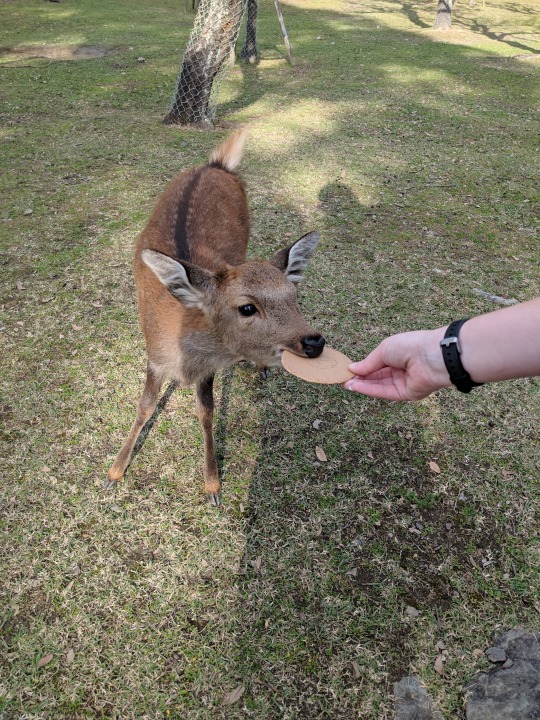
The deer 100% do not care unless you have senbei and will aggressively follow you if they know you have crackers and don't hand them over. They are cute though.
Watch this for your safety!
了解鹿
나라의 사슴을 알자
注意
Warning
警告
주의
奈良公園のシカの多く人に慣れていますがあくまで野生動物です。時として1人を攻撃することがありますので、特にご高齢の方や小さなお子様連れの方は注意してください。
The deer of Nara Park are wild animals. They can occasionally attack people, so please be careful.
奈良公园的鹿属于野生动物、有时会攻击人、所以凊注意安全。
나라공원에 있는 사슴은 야생 동물입이다. 때로는 사람을 공격하기도 하므로 주의하여 주시기 바랍니다.
かむ
Bite
咬人
문다
たたく
Kick
踢人
때린다
突く
Butt
顶人
들이받는다
突進
Knock down
冲撞人
돌진
奈良県 奈良市 春日大社 奈良の鹿愛護会
連絡先 奈良公園のシカ相談室 TEL 0742-26-7755
Japanese
あくまで after all, it must be remembered, simply
突く (つく) to attack
突進 (とっしん) rush, dash, charge
春日大社 (かすがたいしゃ) Kasuga Grand Shrine
愛護 (あいご) protection, tender care
Korean
사슴 deer
야생 wild, feral
때로 sometimes, occasionally
공역하다 to attack
44 notes
·
View notes
Photo
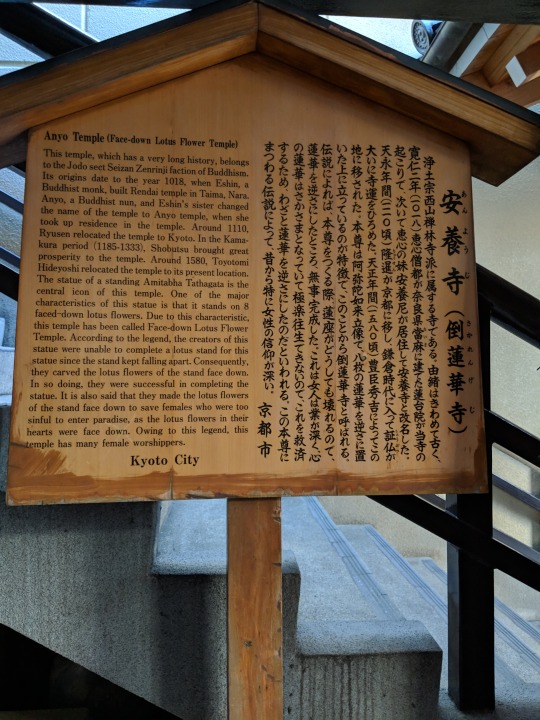

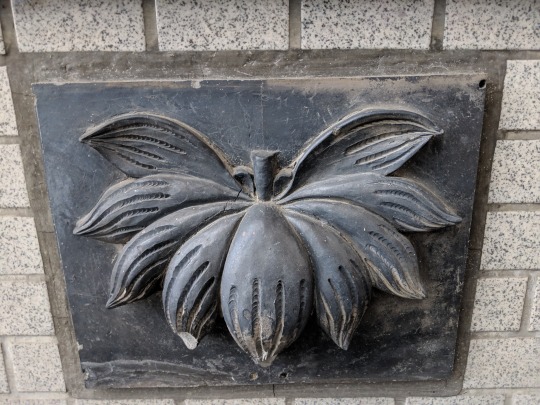
安養寺(倒蓮華寺)
浄土宗西山禅林寺派に属する寺である。由緒はきわめて古く、寛仁二年(一O一八)恵心僧都が奈良県當麻に建てた蓮台院が当寺の起こりで、次いて恵心の妹安養尼が居住して安養寺と改名した。天永年間(三O頃)隆暹が京都に移し、鎌倉時代に入って証仏が大いに寺連をひろめた。天正年間一五八〇頃)豊臣秀吉によってこの地に移された。本尊は阿弥陀如来立像で、八枚の蓮華を逆さに置いた上に立っているのが特徴で、このことから倒蓮華寺と呼ばれる。伝説によれば、本尊をつくる際、連座がとうしても壊れるので、蓮華を逆さにしたところ、無事完成した。これは女人は業が深く、心の蓮華はさかさまとなっていて極楽往生できないので、これを救済するため、わざと蓮華を逆さにしたのだといわれる。この本尊にまつれる伝説によって、昔から特に女性の信仰が深い。 京都市
Anyo Temple (Face-Down Lotus Flower Temple)
This temple, which has a very long history, belongs to the Jodo sect Seizan Zenrinji faction of Buddhism. Its origins date to the year 1018, when Eshin, a Buddhist monk, built Rendai Temple in Taima, Nara. Anyo, a Buddhist nun, and Eshin’s sister changed the name of the temple to Anyo temple, when she took up residence in the temple. Around 1110, Ryusen relocated the temple to Kyoto. In the Kamakura period (1185-1333), Shobutsu brought great prosperity to the temple. Around 1580, Toyotomi Hideyoshi relocated the temple to its present location. The statue of a standing Amitabha Tathagata is the central icon of this temple. One of the major characteristics of this statue is that it stands on 8 faced-down lotus flowers. Due to this characteristic, this temple has been called Face-down Lotus Flower Temple. According to the legend, the creators of this statue were unable to complete a lotus stand for this statue since the stand kept falling apart. Consequently, they carved the lotus flowers of the stand face down. In so doing, they were successful in completing the statue. It is also said that they made the lotus flowers of the stand face down to save females who were too sinful to enter paradise, as the lotus flowers in their hearts were face down. Owing to this legend, this temple has many female worshippers.
Kyoto City
Vocab
安養寺 (あんようじ)Anyo Temple
倒蓮華寺 (さかれんげじ)Sakarenge Temple
浄土宗 (じょうどしゅう)Jodo/Pure Land sect (of Buddhism)
西山派 (せいざんぜんりんは)Seizan sec (of Pure Land Buddhism)
禅林 (ぜんりん)Zen temple
属する (ぞくする)to belong to, be affiliated with
由緒 (ゆいしょ)history, pedigree, lineage
極めて (きわめて)exceedingly, extremely
寛仁 (かんにん)Kanin era (4/23/1017-2.2.1021)
僧都 (そうず)Buddhist priest
當麻 (たいま)Taima
当寺 (とうじ)this temple
起こり (おこり)source, origin, beginning
次ぐ (つぐ)to follow, come after, come next
尼 (あま)Buddhist nun
居住 (きょじゅう)residence, abode, dwelling
改名 (かいめい)name change
天永 (てんえい)Ten’ei era (7/13/1110-7/13/1113)
隆暹 (りゅうせん)Ryusen
鎌倉時代 (かまくらじだい)Kamakura period
証仏 (しょうぶつ)enlightened buddha
大いに (おおいに)very much, considerably, a great deal
天正 (てんしょう) Tensho era (7.28.1573-12.8.1592)
豊臣秀吉 (とよとみひでよし) Toyotomi Hideyoshi
本尊 (ほんぞん) principal object of worship at a temple
阿弥陀如来 (あみだにょらい) Amitabha Tathagara
立像 (りつぞう) standing statue, image
枚 (まい) counter for flat things
蓮華 (れんげ) lotus flower
逆さ (さかさ) inverted, upside down, reversed
倒 means the same as above in this context
伝説 (でんせつ) legend, folklore
連座 (れんざ) lotus seat (under Buddhist statues)
壊れる (こわれる) to break, fall apart
無事 (ぶじ) safely, without incident
女人 (にょにん) woman
業 (ごう) karma, result of one's karma
極楽往生 (ごくらくおうじょう) rebirth in paradise, peaceful death
救済 (きゅうさい) (religious) salvation
わざと deliberately, intentionally
まつる to pray, worship
信仰 (しんこう) (religious) faith, belief
#日本語#japanese language#japanese vocabulary#Japanese langblr#Kyoto#Japan#Buddhism#Japanese history#日本#京京都#日本歴史#仏教
30 notes
·
View notes
Photo


More pictures of the interior of Seishin Temple
[1] 役の行者(神変大菩薩)
水かけの行者さん
浄財浄財
開運隆昌
[2] 鈴成り輪(すずなりぐるま)
お願いをしながら車を回して下さい。
手を、はさまないようご注意ください
Vocab
行者 (ぎょうじゃ)ascetic, pilgrim, devotee
神変 (しんぺん)miracle
菩薩 (ぼさつ)bodhisattva
水をかける (みずをかける)to sprinkle/splash water on
浄財 (じょうざい)monetary offering, donation
開運 (かいうん)better fortune
隆昌 (りゅうしょう)prosperity
挟む (はさむ)to catch, trap, pinch
16 notes
·
View notes